CHEVROLET BLAZER 1997 2.G Owners Manual
Manufacturer: CHEVROLET, Model Year: 1997, Model line: BLAZER, Model: CHEVROLET BLAZER 1997 2.GPages: 402, PDF Size: 21.93 MB
Page 261 of 402
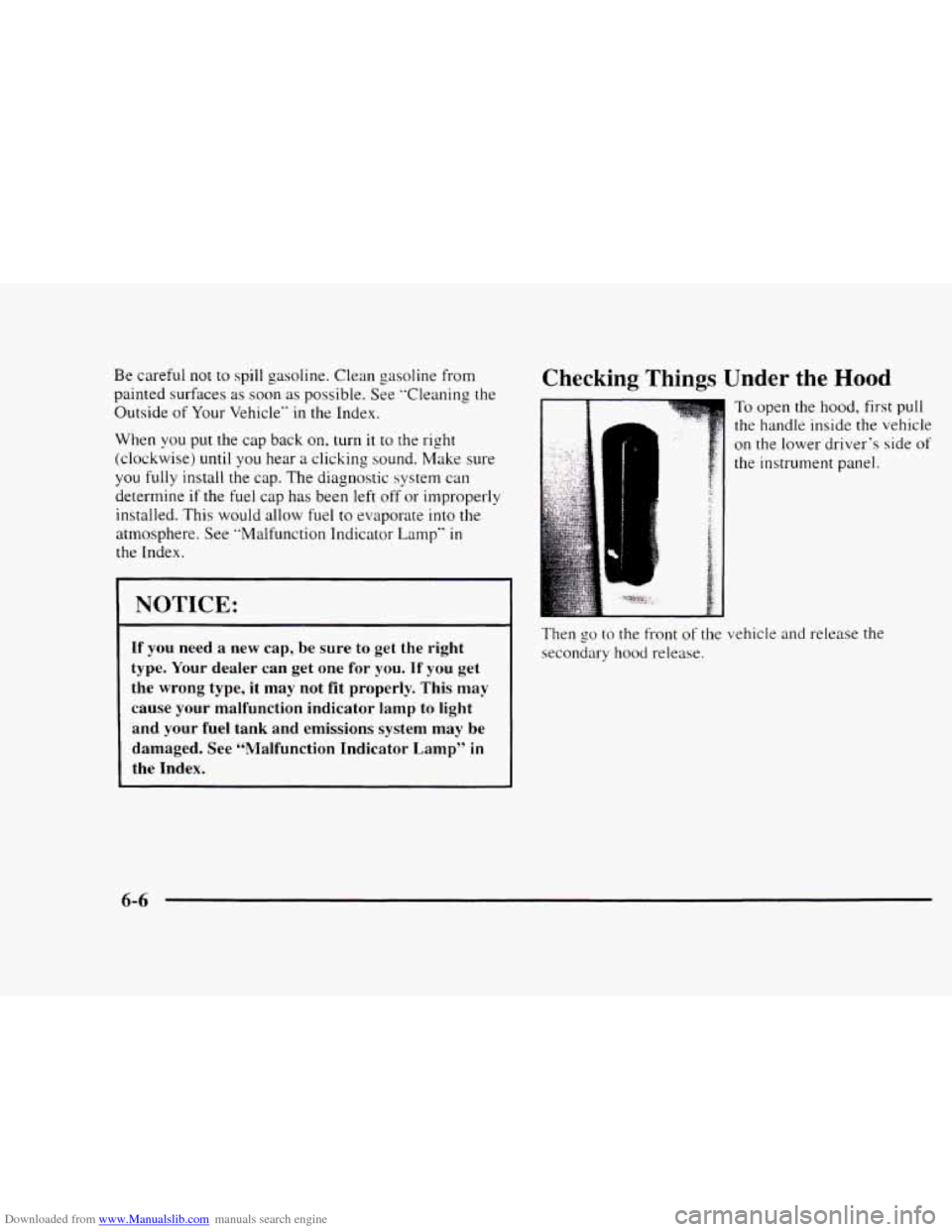
Downloaded from www.Manualslib.com manuals search engine Be careful not to spill gasoline. Clean gasoline from
painted surfaces as soon as possible. See "Cleaning the
Outside
of Your Vehicle" in the Index.
When you
put the cap back on, turn it to the right
(clockwise)
until you hear a clicking sound. Make sure
you fully install the cap. The diagnostic system can
determine
if the fuel cap has been left off or improperly
installed. This would allow fuel
to evaporate into the
atmosphere. See "Malfunction Indicator Lamp"
in
the Index.
NOTICE:
If you need a new cap, be sure to get the right
type. Your dealer
can get one for you. If you get
the wrong type, it may not
fit properly. This may
cause your malfunction indicator lamp to light and your fuel tank and emissions system may be
damaged. See "Malfunction Indicator Lamp"
in
the Index.
Checking Things Under the Hood
1
To open the hood, first pull
the handle inside the vehicle
on the lower driver's side of
the instrument panel.
Then
go to the front of the vehicle and release the
secondary hood release.
6-6
Page 262 of 402
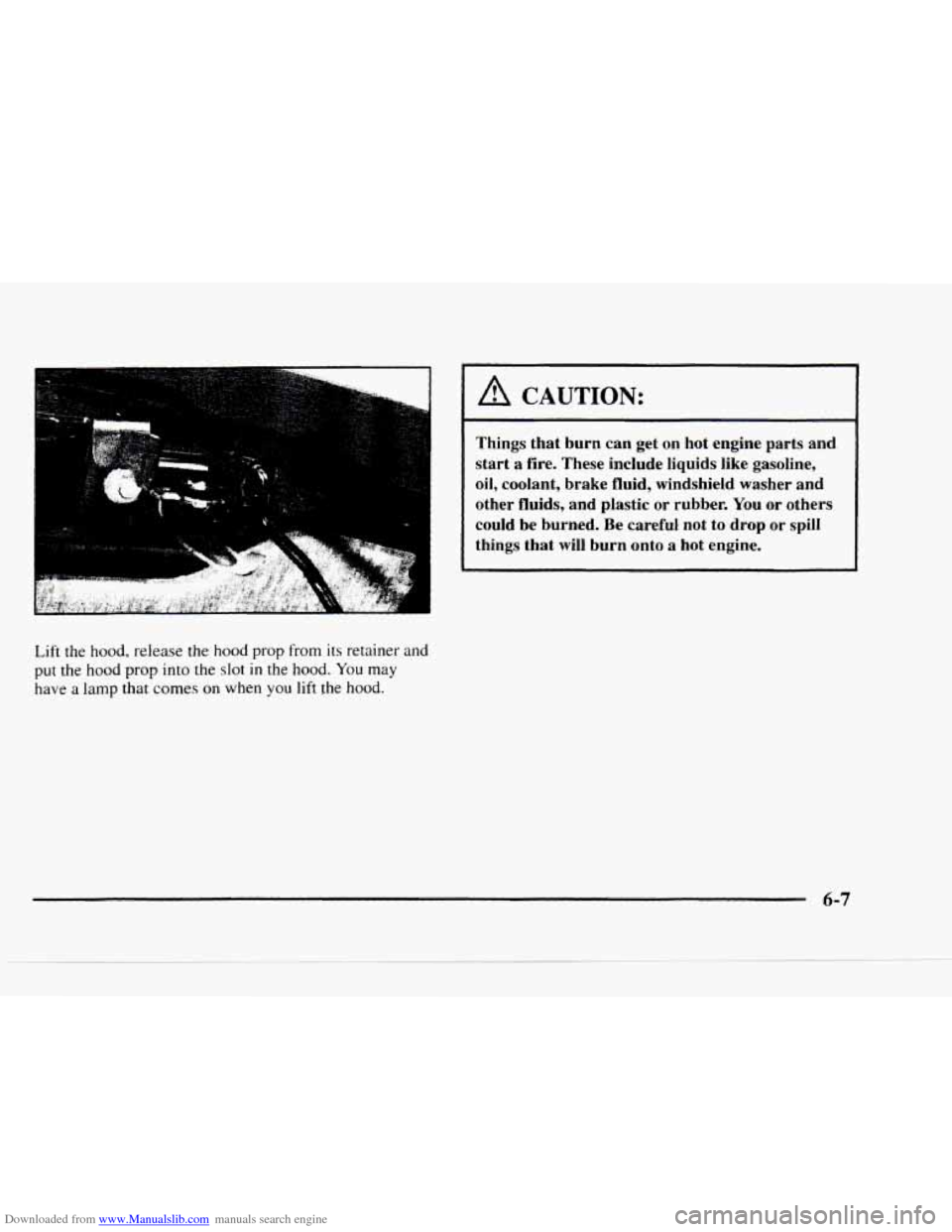
Downloaded from www.Manualslib.com manuals search engine Lift the hood, release the hood prop from its retainer and
put the hood prop into the slot in the hood. You may
have a lamp that comes on when you lift the hood.
I A CAUTION:
Things that burn can get on hot engine parts and
start a fire. These include liquids like gasoline,
oil, coolant, brake fluid, windshield washer and
other fluids, and plastic or rubber.
You or others
could be burned. Be careful not to drop or spill
things that
will burn onto a hot engine.
6-7
Page 263 of 402
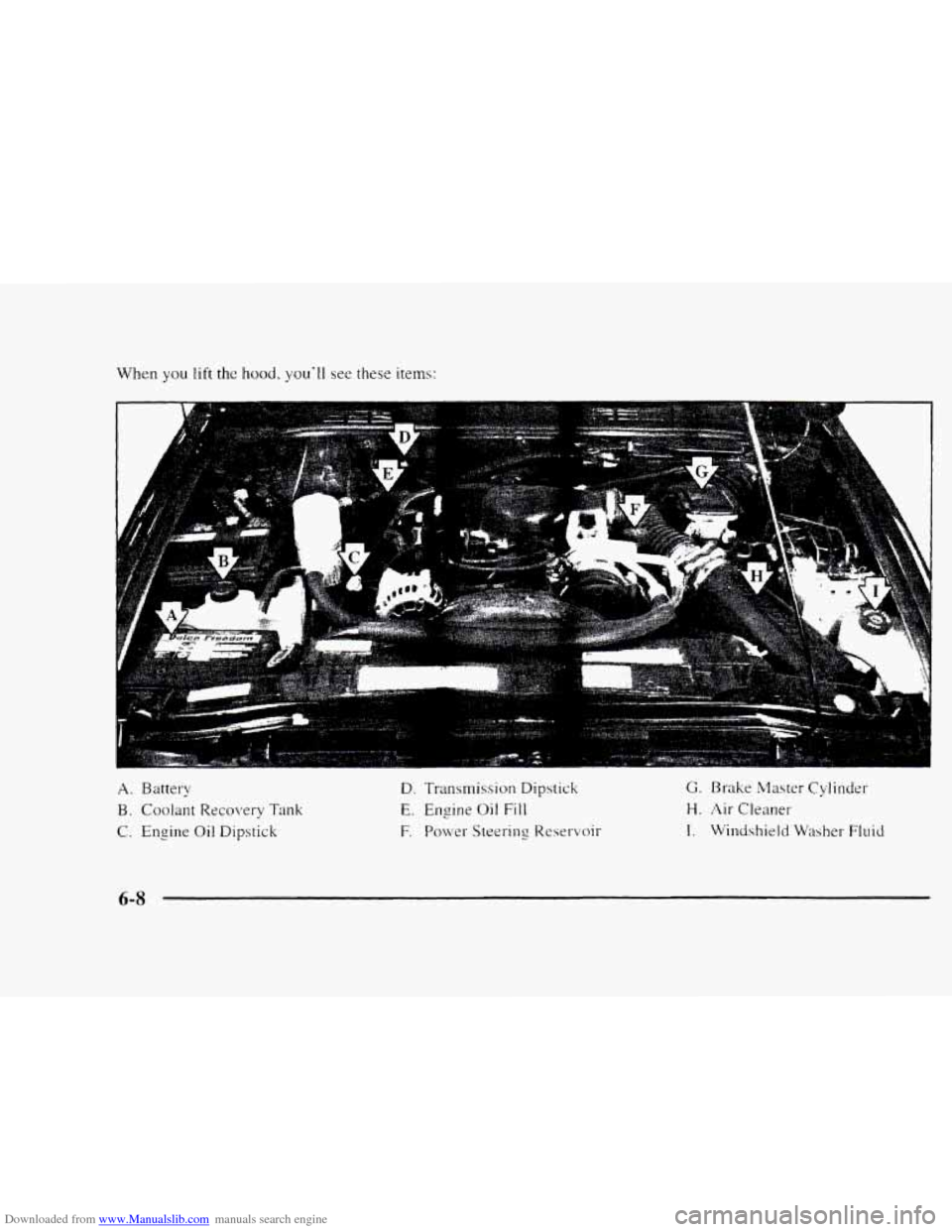
Downloaded from www.Manualslib.com manuals search engine When you lift the hood. you'll see these items:
B -- ."*f . ..
A. Battery
B. Coolant Recovery Tank
C. Engine Oil Dipstick
*
C
D. Transmission Dipstick
E. Engine Oil Fill
F. Power Steering Reservoir
G. Brake Master Cylinder
H. Air Cleaner
I. Windshield Washer Fluid
6-8
Page 264 of 402
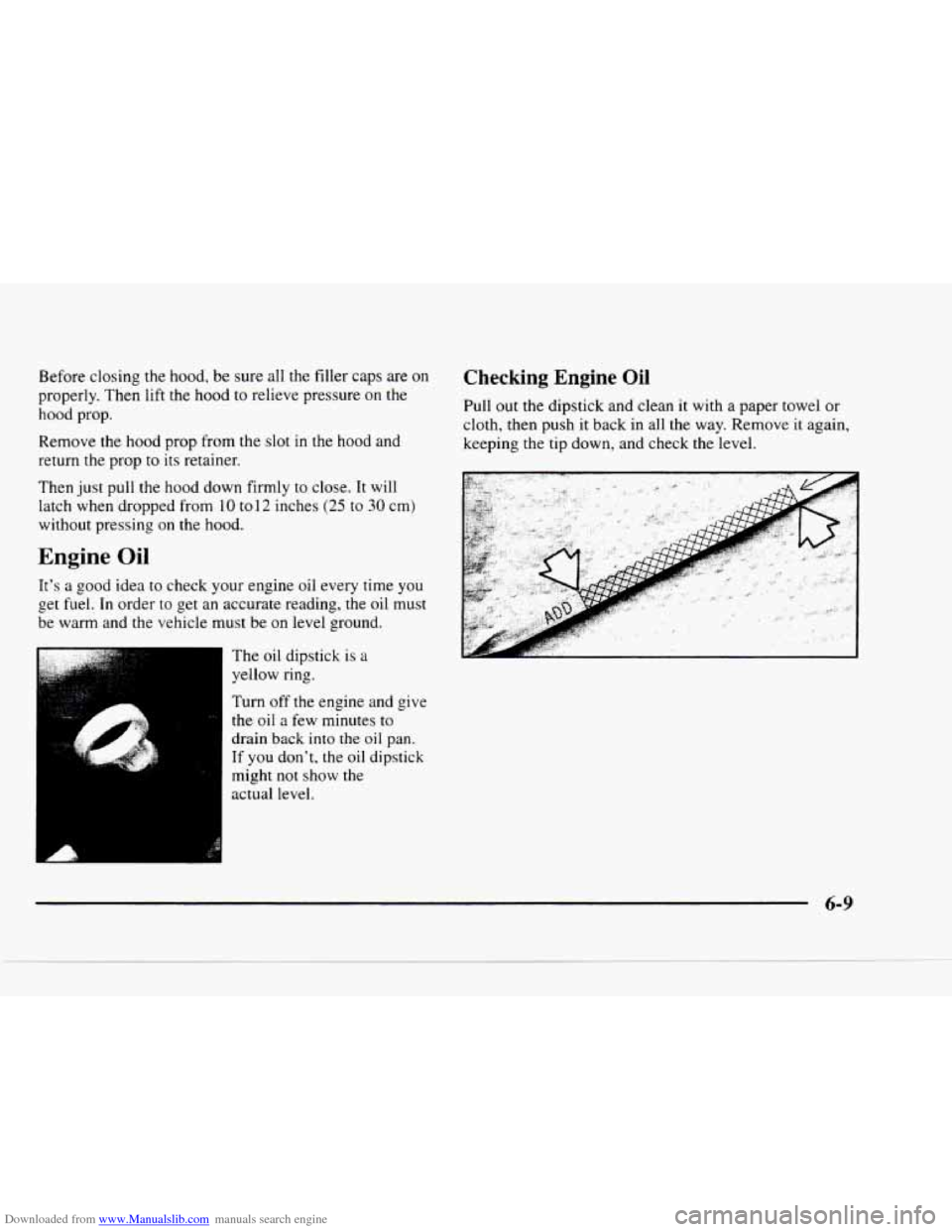
Downloaded from www.Manualslib.com manuals search engine Before closing the hood, be sure all the filler caps are on
properly. Then lift the hood to relieve pressure on the
hood prop.
Remove
the hood prop from the slot in the hood and
return the prop
to its retainer.
Checking Engine Oil
Pull out the dipstick and clean it with a paper towel or
cloth,
then push it back in all the way. Remove it again,
keeping the tip down, and check the level.
Then just pull the hood down firmly
to close. It will
latch when dropped from
10 to12 inches (25 to 30 cm)
without pressing on the hood.
Engine Oil
It’s a good idea to check your engine oil every time you
get fuel. In order to get an accurate reading, the oil must
be warm and the vehicle must be on level ground.
The oil dipstick
is a
yellow ring.
Turn off the engine and give
the oil a few minutes to
drain back into
the oil pan.
If
you don’t, the oil dipstick
might
not show the
actual level.
6-9
Page 265 of 402
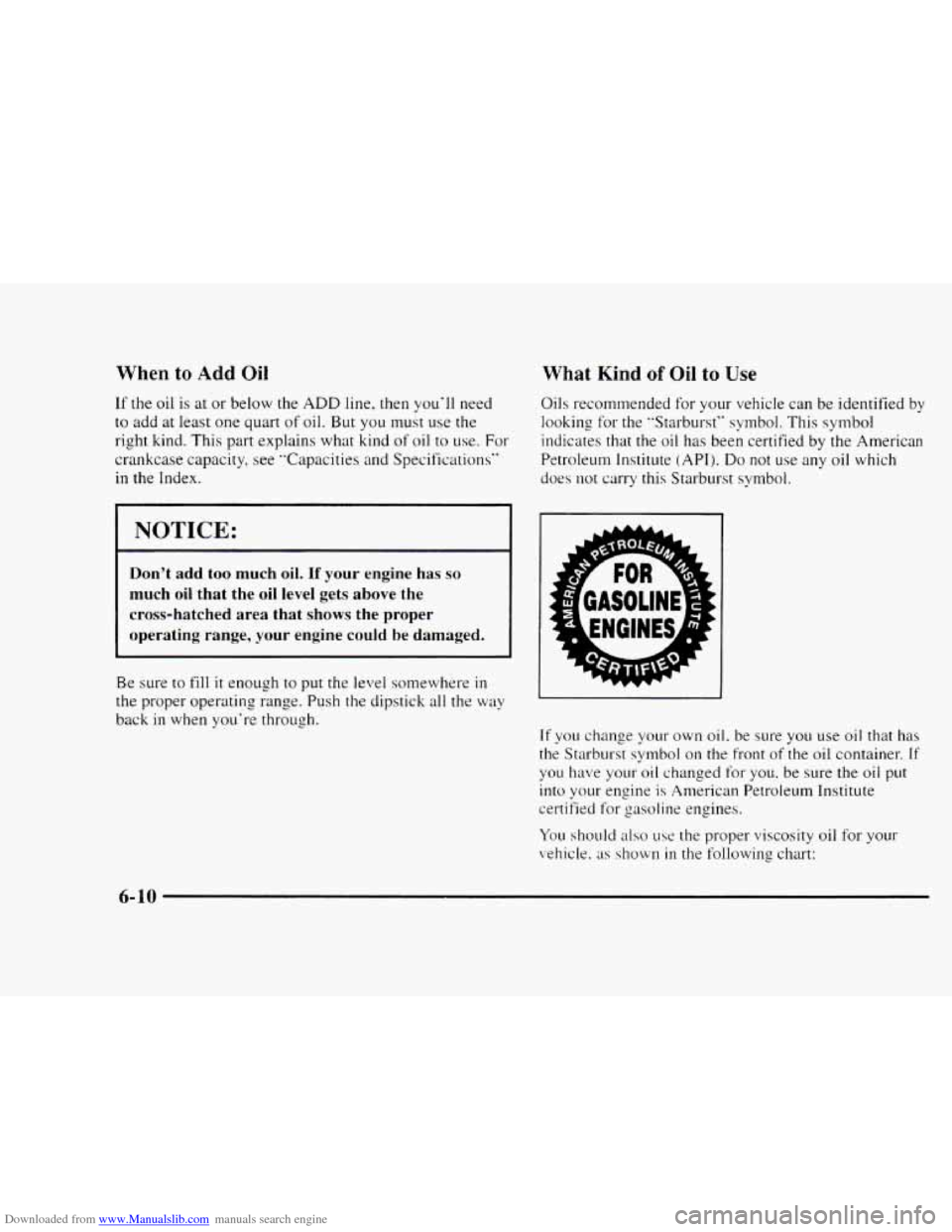
Downloaded from www.Manualslib.com manuals search engine When to Add Oil
If the oil is at or below the ADD line. then you'll need
to add at least one quart of oil. But you must use the
right kind. This part explains what kind
of oil to use. For
crankcase capacity, see "Capacities and Specifications"
in the Index.
NOTICE:
Don't add too much oil. If your engine has so
much oil that the oil level gets above the
cross-hatched area that shows the proper
operating range, your engine could be damaged.
Be sure to fill it enough to put the level somewhere in
the proper operating range. Push the dipstick all the way
back
in when you're through.
What Kind of Oil to Use
Oils recommended for your vehicle can be identified by
looking for the "Starburst" symbol. This symbol
indicates that
the oil has been certified by the American
Petroleunl Institute
(API). Do not use any oil which
does not carry
this Starburst symbol.
If you change your own oil. be sure you use oil that has
the Starburst symbol
on the front of the oil container. If
you have your oil changed for you, be sure the oil put
into your engine is American Petroleum Institute
certified for gasoline engines.
You should
also use the proper viscosity oil for your
vehicle. as
shown in the following chart:
6- 10
Page 266 of 402
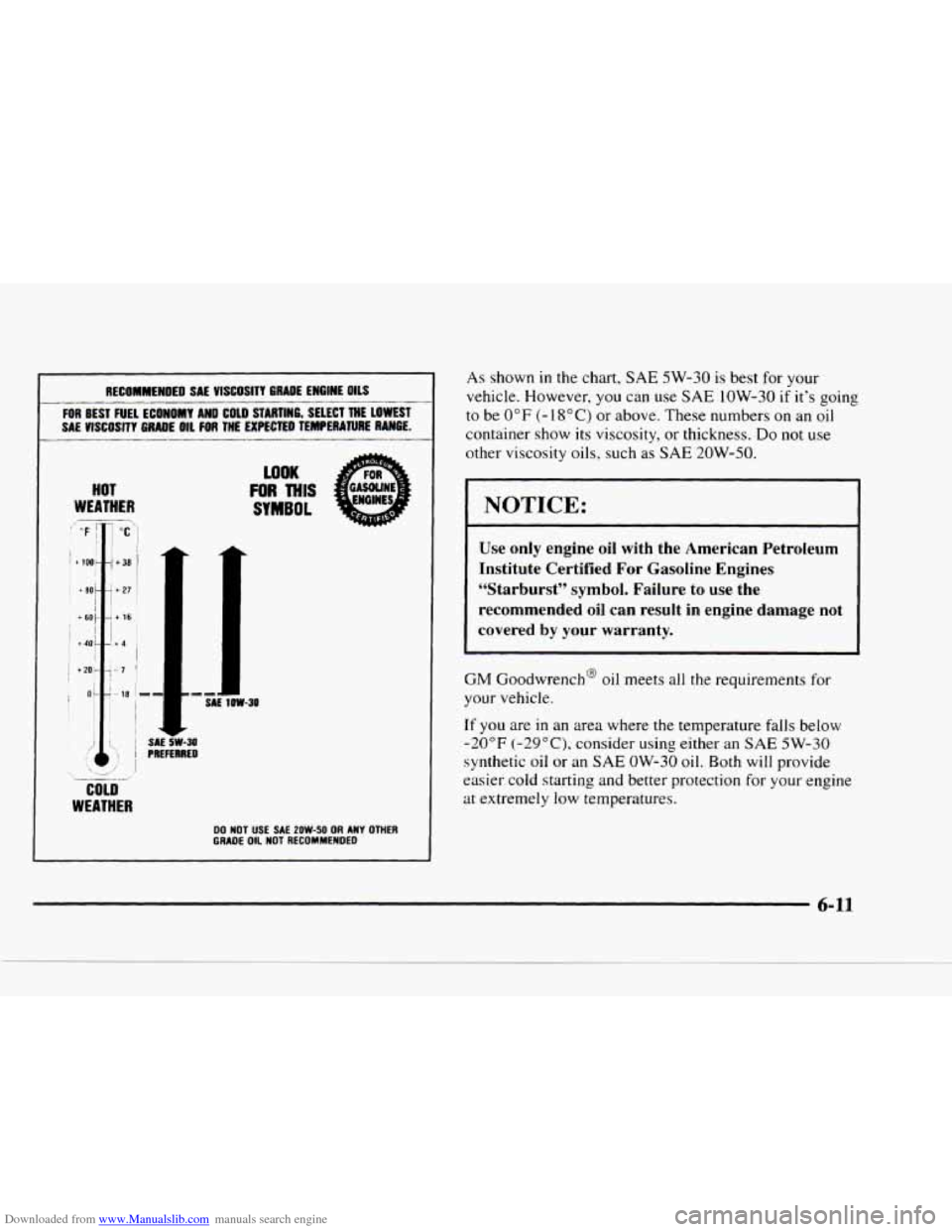
Downloaded from www.Manualslib.com manuals search engine SAL VISCOSITY GRADE ENGINE OILS
FOR BEST FUEL ECONOMY AN0 COLD STARTING, SELECT THE LOWEST
SAE
VISCOSITY GRADE OIL FOR THL'EXPECTED TEMPERATURE RANGE.
HOT
WEATHER
'---.l
COLD
WEATHER
LOOK
FOR THIS
SYMBOL
DO NOT USE SAE 2OW-50 OR ANY OTHER GRADE OIL NOT RECOMMENDED
As shown in the chart, SAE 5W-30 is best for your
vehicle. However, you can use
SAE 1OW-30 if it's going
to be 0" F (- 1 8 "C) or above. These numbers on an oil
container show its viscosity, or thickness. Do not use
other viscosity oils, such as SAE 20W-50.
I NOTICE:
Use only engine oil with the American Petroleum
Institute Certified For Gasoline Engines
"Starburst" symbol. Failure to use the
recommended
oil can result in engine damage not
covered by your warranty.
GM Goodwrench@ oil meets all the requirements for
your vehicle.
If you are in an area where the temperature falls below
-20°F (-29OC), consider using either an SAE 5W-30
synthetic oil or an SAE OW-30 oil. Both will provide
easier cold starting and better protection for your engine
at extremely low temperatures.
6-11
Page 267 of 402
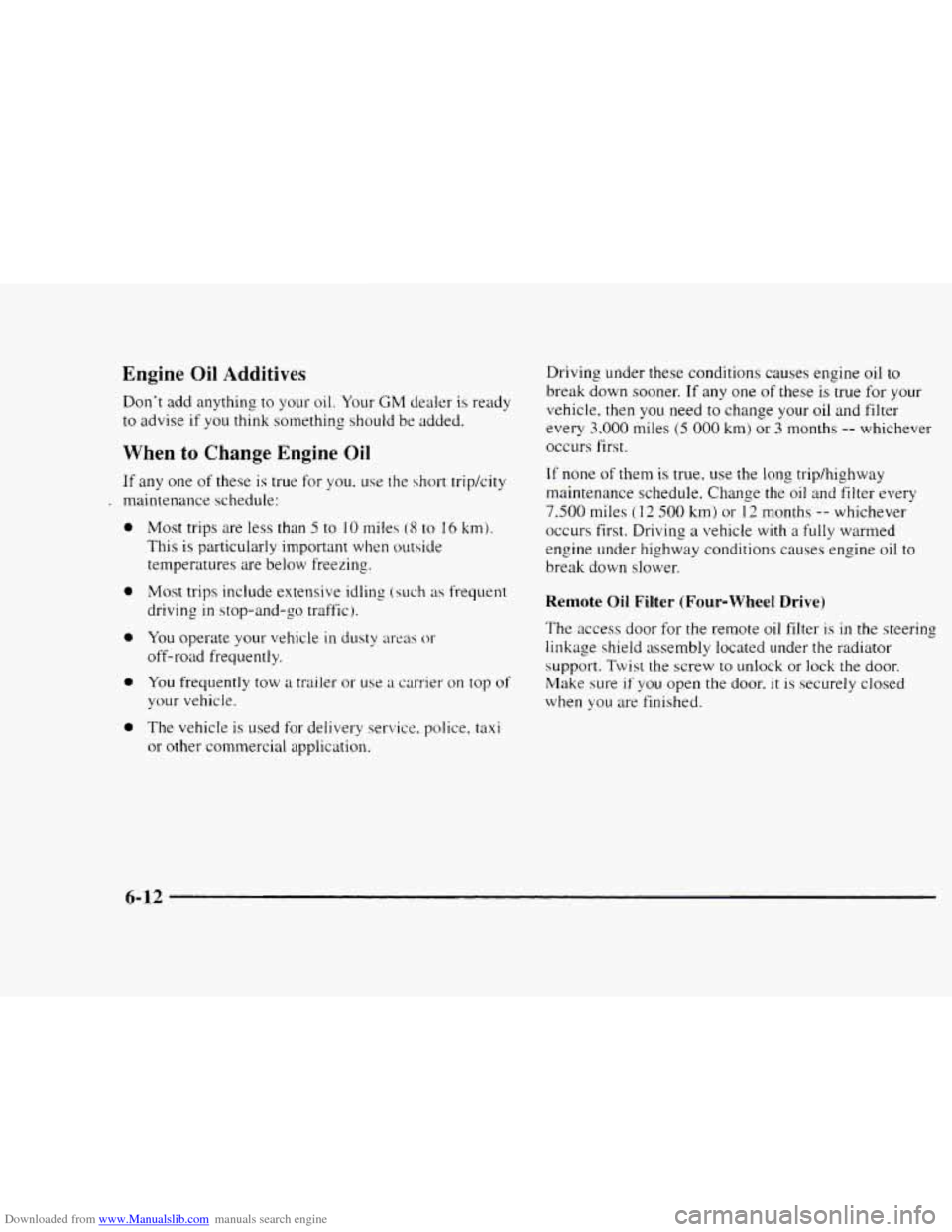
Downloaded from www.Manualslib.com manuals search engine Engine Oil Additives
Don't add anything to your oil. Your GM dealer is ready
to advise if you think something should be added.
When to Change Engine Oil
If any one of these is true for you. use the short tripkity
. maintenance schedule:
a
a
a
0
a
Most trips are less than 5 to 10 miles (8 to 16 km).
This is particularly important when outside
temperatures are below freezing.
Most trips include extensive idling (such
as frequent
driving in stop-and-go traffic).
You operate
your vehicle in dusty areas or
off-road frequently.
You frequently tow
a trailer or use a currier on top of
your vehicle.
The vehicle is used for delivery service. police, taxi
or other commercial application. Driving under
these conditions causes engine oil
to
break down sooner. If any one of these is true for your
vehicle, then you need
to change your oil and filter
every
3.000 miles (5 000 km) or 3 months -- whichever
occllrs first.
If none of them is true, use the long trip/highway
maintenance schedule. Change the oil and filter every
7,500 miles ( 12 500 km) or 12 months -- whichever
occurs first. Driving
a vehicle with a fully warmed
engine under highway conditions causes engine oil
to
break down slower.
Remote Oil Filter (Four-wheel Drive)
The access door for the remote oil filter is in the steering
linkage shield assembly located under the radiator
support.
Twist the screw to unlock or lock the door.
Make sure
if you open the door. it is securely closed
when
~OLI are finished.
6-12
Page 268 of 402
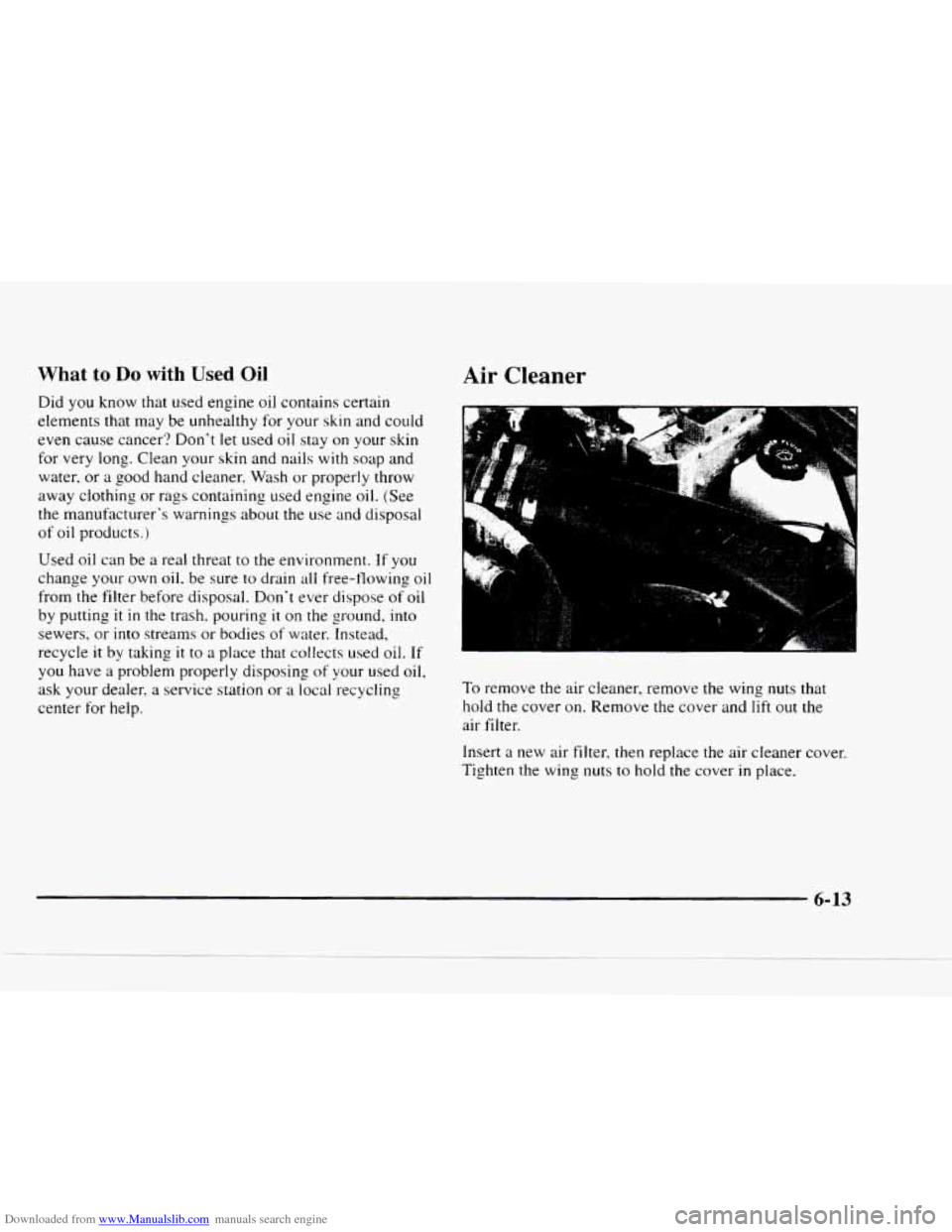
Downloaded from www.Manualslib.com manuals search engine What to Do with Used Oil
Did you know that used engine oil contains certain
elements that may be unhealthy for your skin and could
even cause cancer? Don't let used oil stay on your
skin
for very long. Clean your skin and nails with soap and
water, or
a good hand cleaner. Wash or properly throw
away clothing or rags containing used engine oil. (See
the manufacturer's warnings about the use and disposal
of oil products.)
Used oil can be a real threat
to the environment. If you
change
your own oil. be sure to drain all free-flowing oil
from the filter before disposal. Don't ever dispose of oil
by putting
it in the trash. pouring it on the ground, into
sewers, or into streams or bodies of water. Instead,
recycle it by taking
it to a place that collects used oil. If
you have a problem properly disposing of your used oil,
ask your dealer, a service station or a local recycling
center
for help.
Air Cleaner
cr
To remove the air cleaner, remove the wing nuts that
hold
the cover on. Remove the cover and lift out the
air filter.
Insert
a new air filter, then replace the air cleaner cover.
Tighten the wing
nuts to hold the cover in place.
- .. 6-13
Page 269 of 402
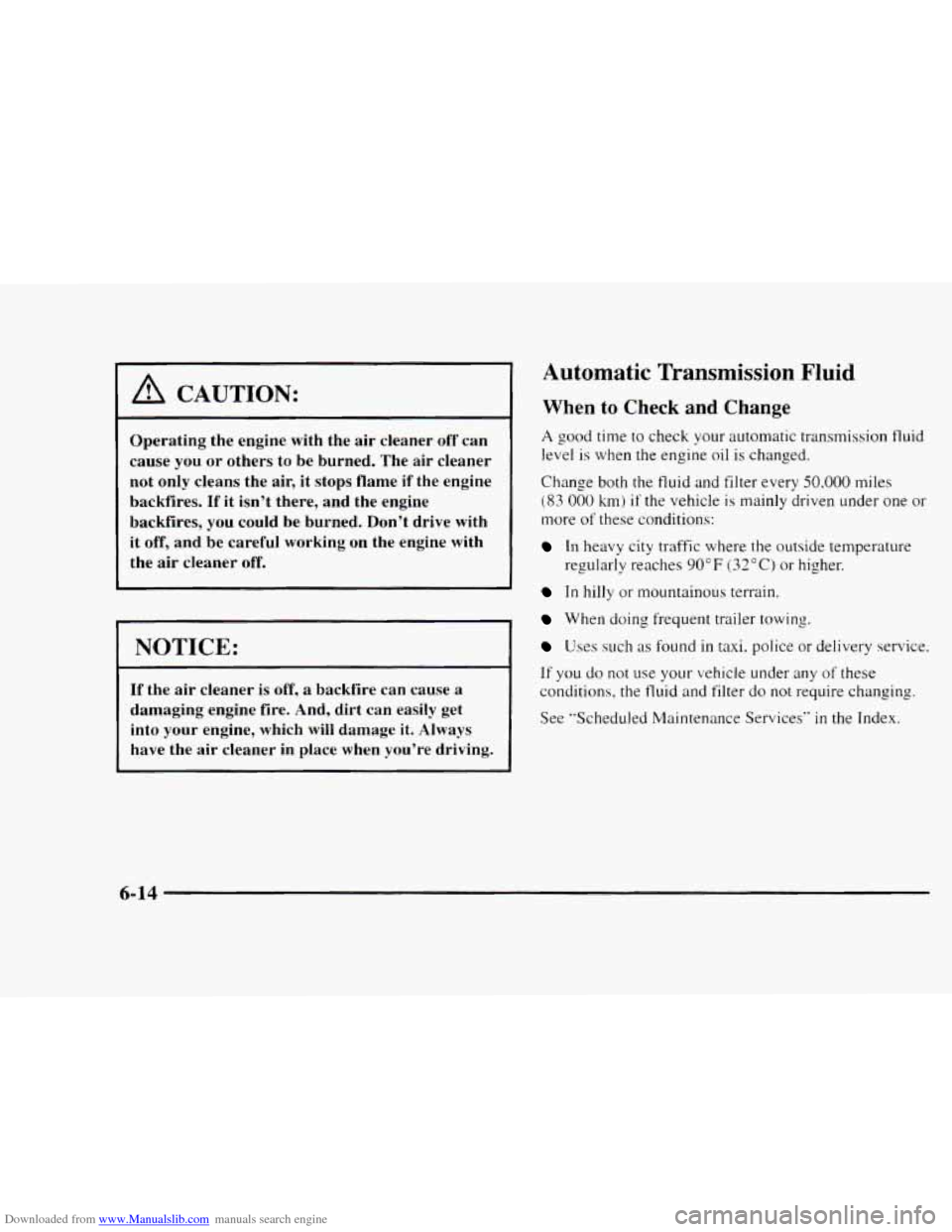
Downloaded from www.Manualslib.com manuals search engine A CAUTION:
Operating the engine with the air cleaner off can
cause you or others to be burned. The air cleaner
not only cleans the
air, it stops flame if the engine
backfires.
If it isn’t there, and the engine
backfires, you could be burned. Don’t drive with
it
off, and be careful working on the engine with
the air cleaner
off.
NOTICE:
If the air cleaner is off, a backfire can cause a
damaging engine fire. And, dirt can easily get
into your engine, which will damage
it. Always
have the air cleaner in place when you’re driving.
Automatic Transmission Fluid
When to Check and Change
A good time to check your automatic transmission fluid
level is when the engine oil is changed.
Change both the fluid and filter every
50,000 miles
(53 000 km) if the vehicle is mainly driven under one or
more
of these conditions:
In heavy city traffic where the outside temperature
regularly reaches
90°F (32°C) or higher.
In hilly or mountainous terrain.
When doing frequent trailer towing.
Uses such as found in taxi. police or delivery service.
If you do not use your vehicle under any of these
conditions, the fluid and filter
do not require changing.
See “Scheduled Maintenance Services”
in the Index.
6-14
Page 270 of 402
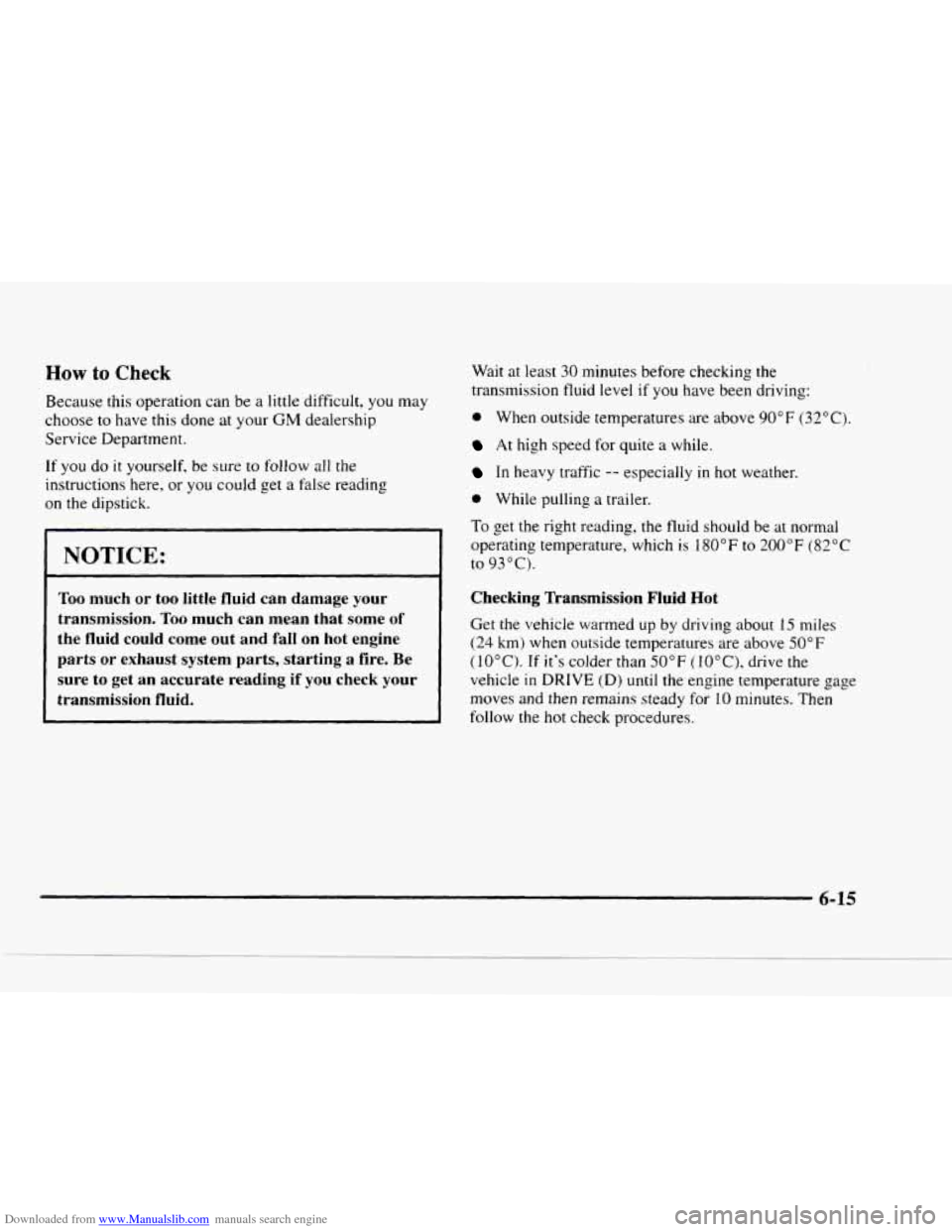
Downloaded from www.Manualslib.com manuals search engine How to Check
Because this operation can be a little difficult, you may
choose
to have this done at your GM dealership
Service Department.
If
you do it yourself, be sure to follow all the
instructions here, or
you could get a false reading
on
the dipstick.
NOTICE:
Too much or too little fluid can damage your
transmission.
Too much can mean that some of
~ the fluid could come out and fall on hot engine
parts
or exhaust system parts, starting a fire. Be
' sure to get an accurate reading if you check your
transmission fluid.
Wait at least 30 minutes before checking the
transmission
fluid level if you have been driving:
0 When outside temperatures are above 90°F (32°C).
At high speed for quite a while.
In heavy traffic -- especially in hot weather.
0 While pulling a trailer.
To get the right reading, the fluid should be at normal
operating temperature, which is
180°F to 200°F (83OC
to 93°C).
Checking Transmission Fluid Hot
Get the vehicle warmed up by driving about 15 miles
(24 km) when outside temperatures are above 50°F
(IOOC). If it's colder than 50°F (IOOC), drive the
vehicle
in DRIVE (D) until the engine temperature gage
moves and then remains steady for
10 minutes. Then
follow the hot check procedures.
6-15